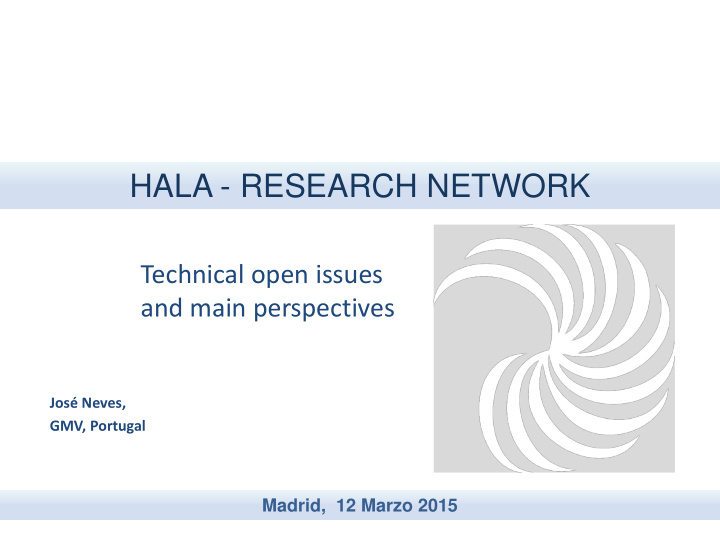



HALA - RESEARCH NETWORK Technical open issues and main perspectives José Neves, GMV, Portugal Madrid, 12 Marzo 2015
Source:Air Care Aviation, Carolina Cessna Dealer Serving both the ...www.aircareav.com
Reducing Crew Workload Improved human machine interaction; Increased automation; Improved support in case of abnormal conditions; Improved situational awareness tools.
Reducing Crew Workload Crew reduction can also be unintentional or unplanned… British Civil Aviation Authority reported 32 occasions in 2009 when pilots were incapacitated during a flight, due to illness or psychological issues; The actual safety levels can only be assured through mature crew resource management, focus on the concept of two pilots sharing information, complementing &cross-checking each other; Changing this paradigm requires the introduction of new technologies, the definition of new automatisms, but also changes in the cockpit design philosophy and in the crew role .
Reducing Crew Workload What we shall consider / remember Increased automation, seen as a solution to excessive workload can, however, introduce new problems (Hollnagel, 2012). Bainbridge (1983) addressed this issue, describing what he called the ironies of automation , which may be more time consuming and incomprehensible than the manual operation of a system As we think about employing new technologies, it is also important to remember that the introduction of new technologies and procedures designed to increase safety and efficiency can lead to new forms of error (Weiner & Curry, 1980; Norman, 1990; Billings, 1997).
Looking further to single pilot cockpit concept … The absence of any form of cross checking between pilots. No fatigue avoidance countermeasure such as conversation No safeguard against inadvertent napping by the single pilot remaining on the flight deck. Normal, abnormal, and emergency procedures are all written based on the assumption of a two-pilot operation; Standard Operating Procedures dealing with non-normal and emergency events invariably call for one pilot to fly the aircraft and the other to action the check list. Security implications of having only one pilot locked in the flight deck Physiological needs are not taken into account One of the cornerstones of flight safety is redundancy
ODICIS cockpit [source: http://www.airtrafficmanagement.net/wpcontent/uploads/2012/07/Odicis1_Felix-et-associ%C3%A9s-2.jpg
Enabling Technologies Crew monitoring – Cameras (vision systems), body worn devices … Displays and controls – Advanced displays (haptic, touch, SVS, 3D, reconfigurable) – Pilot Assistance Communications – Digital data over air-ground data links Aeronautical information and mission management – Electronic Flight Bag (EFB) systems, the paper as “hardware” Automation – Electronic Pilot – Electronic Standby Pilot Computer
Enabling Technologies Crosschecking New interaction design between pilot and the new system intelligence (more active interaction/discussions BUT less pilot inputs for simple tasks) New system intelligence using pilot inputs and complex operational information Executing tasks during high workload situations Doing basic communication by needing advanced digital communications (advanced CPDLC,...) Creating solutions for existing problems Higher system intelligence with more transparent/self- explaining and adaptive results
Technology Considerations which of the technologies, or combination of technologies, delivers the benefits that are needed for the future cockpit ? Safety, operational and performance aspects Threats, potential issues and potential drawbacks to be expected including the mitigation of risks Maturity, affordability and flexibility for adaption in the cockpit Real increase in pilot performance
Technology Considerations The objective of Crew Monitoring System is to evaluate crew capabilities and behavior, in order to identify (and prevent) peak workload situations, and support reduced crew operations in specific operational conditions. Presence/Identification of the crew inside the cockpit Signs of crew incapacitation (strokes, hypoxia, etc.) Sleepiness/Drowsiness and sleeping Distraction/Inattention to cockpit instruments Stress/Mental workload Situational Awareness/Activity
Technology Considerations Potential sensing technologies that can be considered in CMS Monoscopic vision systems & Passive multi-cameras systems 3D cameras & Worn cameras Polygraph/set of combined sensors & Body worn sensors Biochemical sensors & - Functional Near-Infrared sensor Pad Radar sensors in seat & Sidestick electrodermic sensors Sidestick pressure sensor & - Seats pressure sensors Microphone Analysis of crew inputs in Avionics Systems Analysis of Avionics parameters
Technology Considerations Integration of vision systems in a cockpit is one of the major issues as they are very few potential available areas where to place a camera. To observe pilot face, camera must be located in the axis of the nominal head pose (head position and orientation) of the pilot and below the eye to ensure a good eye visibility. The pilot’s acceptability to cameras technology must be investigated. “ big brother is watching you” feeling . … In counterpart pilot monitoring may not be necessary for a good part of a flight
Technology Considerations Scientific and technical aspects of crew monitoring are challenged by Human Factors and societal issues Inter individual variability Crew acceptability regarding personal comfort Suitability to the various postures and tasks required by air crews Crew acceptability regarding professional aspects (consequences on job qualification, management issues, carreer, etc.) Crew acceptability considering pilots as individuals (privacy, self esteem, etc.) Ethics and legal implications
Reaching Higher Level of Automation Selection and employ of useful technologies & procedures To have an interaction of the human to all levels of automation depending on the situation Change a paradigm in system design: cut of automation in hard situation to design basic automation for all situations Leaving one pilot in the cockpit has also to deal with, when the one pilot gets absent Remote control Full automated emergency landing Crew monitoring to detect this
Recommend
More recommend